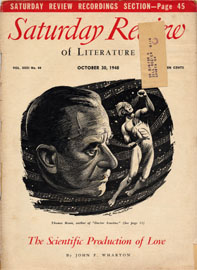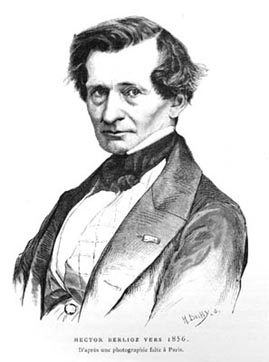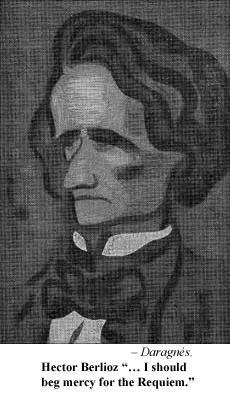
Berlioz and Four Brass Bands
By
Robert Lawrence
© Robert Lawrence
Published in

 |
Berlioz and Four Brass BandsBy Robert Lawrence © Robert Lawrence Published in |
 |
BERLIOZ: “La Grande Messe des Morts.” Emile Passani Choir and Orchestra, conducted by Jean Fournet, with Georges Jouatte, tenor. (Columbia album 769, $15.50.)
THERE is a whole body of Berlioz’s operatic and choral music which for various reasons—expense of proper mounting, indifference of conductors, difficulty of execution—is not known to music-lovers in this country. Neither “The Trojans” nor “Beatrice and Benedict” has ever been given here in operatic form. The “Te Deum,” played at the opening of Carnegie Hall in 1891, has rarely been heard from since. The “Symphonie Funèbre et Triomphale,” though made accessible in a version by the Goldman Band, has never been offered in its original grandeur; and the “Grande Messe des Morts”—commonly known as the “Requiem”—is more of a legend than an actuality. Its performances in the United States have been infrequent.
Much has been made of Berlioz’s use of massed forces in the Requiem. Standard strictures have found their way into music histories about the work’s bombastic style. And, because it is so prohibitively expensive to perform—and therefore goes unheard—most of us have been unable to question these verdicts at first hand.
The Requiem was recorded in Paris five years ago by the Pathé-Marconi Company at the Church of St. Eustache. In repressing this issue for the American market, Columbia has rendered a cultural service. Now it is possible to hear and evaluate the work for oneself. Certain of its basic ingredients have been lost (more of that later) in the process of recording; but even a reasonable facsimile of this masterpiece, available to students and music lovers, should mark a further step in the revised estimate of Berlioz that is already being formed in this country.
The forces employed are vast: a mighty wind section, more than a hundred strings, four brass bands, sixteen timpani, ten pairs of cymbals, and four tam-tams, a chorus of over two hundred. Berlioz, in the full score, adds: “These numerical indications are merely relative. If the locale permits, the vocal mass may be doubled or tripled, and the instrumental choirs increased accordingly."
Surprisingly enough, the work is not mechanically difficult
to perform. Berlioz’s unsurpassed knowledge of acoustical values led him to
write broad, vaulting music for the forces employed. The instrumental parts bear
little relationship to the intricacies of the “Fantastic Symphony,” “Harold in Italy,” or “Romeo and Juliet.” They could be encompassed technically by a student orchestra. Nor is Berlioz’s writing for chorus especially demanding. It is the synchronization of the massed musicians,
the interpretative grasp of the score that place the burden almost entirely upon
the conductor. One fervently hopes that Arturo Toscanini, before he lays aside
his baton, will present this score in live performance to an American audience.
Berlioz once wrote, “If I were threatened with the destruction of all my works but one, I should beg mercy for the Requiem.” The composition of this giant mass caused him no end of personal and financial worry. After all sorts of complications at the Ministry of the Interior, which had commissioned it, the “Grande Messe des Morts” was given a first hearing in 1837 at the Church of the Invalides in Paris, as part of a memorial service to the French military hero General Damrémont. For some time afterwards Berlioz had trouble getting the ministry to pay him for the expenses of the performance and for his own labors in composition.
The style of the work, though not nearly so flamboyant as the Requiem of Verdi, is nevertheless non-liturgical. It offers a series of incomparable tone pictures on the subject of death and the hereafter, rather than the staunch expression of any given creed. But the manner is consistently lofty, the content profound.
It will come as a surprise to those who are acquainted with the Berlioz Requiem only by hearsay, that no more than three sections—the Dies Irae, Rex Tremendae Majestatis, and Lacrimosa—employ the full orchestra. The essential mood is dark and spare. Among its many intimate pages, most memorable are the opening Kyrie, in whose later measures—as the chorus sings “Fiat Lux”—the orchestra seems to flicker like a dying candle and then spark celestially above the massed voices; the beautiful Quaerens Me, for unaccompanied chorus, in which Berlioz demonstrates that instrumental color was not an indispensable part of his genius; the Offertorium, beloved of Schumann, with its long development of a Gregorian-style theme in the orchestra against the mournful repetition by the chorus of only two notes (this entire section has a marked resemblance to the funeral procession from the “Romeo and Juliet” symphony, completed two years later); and the closing Agnus Dei, which contains—for this writer’s taste—the most affecting pages in all of Berlioz. Here the composer first brings back the music of the Kyrie, with its unforgettable “Fiat Lux”; then, with a melting modulation, he reintroduces—in a feeling of solace so personal that it must be heard rather than described—the climactic phrase of the Rex Tremendae; and, finally, above throbbing chords in the timpani and the weaving of strings, he gives the chorus an “Amen” that conveys not the shadowy gloom of the cathedral but rather the peace of the grave.
ONLY one vocal soloist is called for in the Requiem; the tenor who sings, with choral background, the Sanctus. If the reader has any doubt of Berlioz’s powers as a melodist or master harmonist, I refer him expressly to this section of the work, a page further remarkable for the accompaniment of five pairs of cymbals played pianissimo—like whirring wings—against the tender music of the soloist. The only cut in the entire recording has been made at this point to avoid the duplication of repetitive passages for both soloist and chorus. It would have been more desirable, in view of the score’s large-scale architecture, to retain them.
The really massive numbers of the Requiem are built for the sonorities of a huge church, like the Invalides in Paris or St. Patrick’s in New York. Part of their effect lies in the reverberation heard in live performances, the physical impact on the human ear. Diffuseness of sound is a calculated part of the work’s construction. When the Requiem has been compressed, so to speak, on discs, certain acoustical marvels of the music—however well recorded—are diminished in their impressiveness. For example, the famous blend in the Hostias of three flutes with eight trombones (four on one side of the church and four on the other), loses the spatial element which makes it so interesting in performance. Nor does the entrance of the four brass bands, as they proclaim the Day of Judgment —one at every point of the compass—give altogether the idea of great distances intended by the composer. Even with these defects, perhaps insuperable, the current recording is a fine one, with the Emile Passani chorus and orchestra well—if not memorably—directed by Jean Fournet. It seems to me that the original Columbia discs, which I heard in Paris, had a more luminous tone than those now issued by Bridgeport.
The most famous section of the Requiem remains, of course, the Dies Irae; and the new set is worth having for this alone. Starting with an insistent plain-chant melody for cellos, basses, and chorus, it is twice interrupted by an upward, ominous run of the strings. On the third sweep, the Tuba Mirum arrives. The four bands sound first in unison, then in rhythmical counterpoint; and if one is disposed to accuse Berlioz of using needless instruments here, a study of the score is recommended. The diversity of rhythmic and harmonic effect in all four bands, emerging in combination like the tone of a giant organ, is startling. As the call to Judgment reaches its climax, the male chorus enters above the thundering of the timpani. Once more the pealing brasses are heard—this time together with the voices; and as they rise a second time to the apex of the Requiem, the crack of doom resounds.
It is noteworthy that this is the only place in the entire work—one bar, to be exact—where Berlioz has used the combined mass of cymbals and tam-tams. In a stroke designed to suggest the opening of the earth he could hardly have done less; and esthetically he stands on as valid ground, seeking the ultimately monumental in music, as did Michelangelo and Tintoretto in planning their vast frescoes of Paradise. One can take the baroque or leave it, not deny it.
Unfortunately, the crack of doom is not heard with the required force or distinctness on the records. One has the impression that the engineer was over-cautious at this point. The magnificence of the Lacrimosa, another of the Requiem’s big numbers, is captured more successfully in performance.
It is to be regretted that Columbia did not issue a translation of the handsome booklet provided with the French edition of the recording. The current American manual contains the text of the Requiem but is marred by an introduction which, limited in scope, also carries some factual errors. This is a small point, though, beside the gain of having at hand a dignified and authentic recording of the “Grande Messe des Morts.” Perhaps the invisibility of the forces employed will oblige the listener to concentrate entirely on what so many commentators have ignored in the work till now: not the mechanical means—which are incidental—but the deeply moving artistic end.
![]()
* This article and the pictures that
accompany it have been scanned from a
contemporary copy of the Saturday Review of Literature,
30 October 1948 (pages 55 and 59-60), in our own collection. We have preserved the author’s original spelling,
punctuation, and syntax, but have corrected obvious typographical errors.![]()
We have not been able to contact the editor of this issue of the Saturday Review of Literature, which has ceased publication.
![]()
The Hector Berlioz Website was created by Monir Tayeb and Michel Austin on 18 July 1997; this page created on 20 September 2011.
© Monir Tayeb and Michel Austin. All rights of reproduction reserved.
![]() Back to Original Contributions page
Back to Original Contributions page
![]() Back to Home Page
Back to Home Page
![]() Retour à la page Contributions Originales
Retour à la page Contributions Originales
![]() Retour à la Page d’accueil
Retour à la Page d’accueil